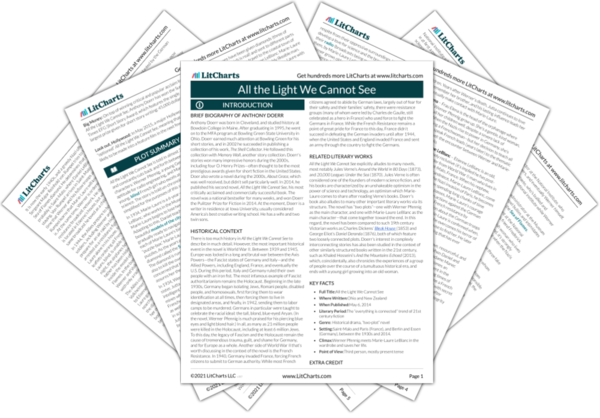Summary
Analysis
As the story begins, Marie-Laure LeBlanc is a tall, pretty 6-year-old living in Paris. She’s slowly going blind. Her father Daniel works in the Natural History Museum, and decides to send his daughter on a children’s tour. The tour guide, who directs the children with a cane, draws their attention to the wonders of the museum: dinosaur skeletons, stuffed birds, etc.
The contrast between the Prologue and the beginning of Part One is jarring, and now it becomes clear that Doerr is going to give us all the backstory leading up to the bombing of Saint-Malo. It’s now 1934, so WWII is still years in the future. The Natural History Museum immediately brings up the idea of science again—an ordered way of looking at the world, and observing slow, gradual change (like dinosaur skeletons, or the history of Saint-Malo).
Themes
The tour guide enjoys entertaining the children, and tells them that on the 13th floor of the museum there is a diamond called the “Sea of Flames.” He tells the children the story behind it: long ago, in Borneo, there was a prince who was attacked by robbers. The robbers stole the prince’s possessions, except for the beautiful blue stone he had clenched in his hand. Amazingly, the prince survived his wounds, and concluded that the stone had miraculous healing powers. He noticed that the stone had a strange red streak inside it—a kind of flame. He decided to call the stone the “Sea of Flames.” As time went on, however, the prince discovered something horrible: although the Sea of Flames kept its owner in good health, it caused all of its owner’s loved ones to die. The prince decided to keep the stone, even though his entire family died tragically as a result. The prince retreated from public life—some say he became a humble farmer who never grew old.
Doerr introduces us to the theme of fate in explicit terms. The challenge of the Sea of Flames, as we’ll see, is to decide whether the “curse” is real or not—or if the idea of a “curse” in fact affects how people act, so that it is essentially a self-fulfilling prophecy. In basic terms, this is a conflict between the idea of fate and free will—a conflict the novel will explore and complicate. The legend of the diamond ends with isolation: the prince becomes a humble farmer, choosing to live apart from other people for fear that he could kill them. Based on the Prologue, we can’t help but wonder if this is how Doerr’s novel ends, too: all the characters isolated from one another, afraid (or unable) to make connections of any kind. For now the Sea of Flames story seems merely symbolic, but soon the diamond itself will appear as an important object.
Themes
The tour guide continues his story. Years after the prince found the stone, traders in India discovered a beautiful diamond. A duke bought the stone from the traders, and soon after he did so, his loved ones began to have tragic accidents and die. The duke was so terrified that his diamond could be the Sea of Flames that he decided to donate it to the museum. To this day, the stone is kept on the 13th floor, far from visitors’ eyes. Marie-Laure asks the tour guide why he doesn’t just throw the stone away. The tour guide replies that the stone is simply too valuable to throw away.
Doerr wants us to note the paradox of the diamond: it’s extremely dangerous, but it’s also incredibly beautiful and valuable. One obvious point to take away from this is that some humans are controlled by their own selfishness (although, tellingly, Marie-Laure doesn’t seem to be). But perhaps a more important lesson of the Sea of Flames story is that humans often cling to the concept of fate, even when it’s dangerous and destructive. There are times when humans want to be controlled by fate. Even if it is a negative force, it is still a way of making sense of the world and giving meaning to the meaningless.
Themes
After the tour, Marie-Laure thinks about what the guide has told her. She wonders if it would be hard to find the Sea of Flames. A month later, she goes totally blind.
We can’t help but associate these two facts: Marie-Laure going blind and Marie-Laure learning about the stone that brings misfortune. Even if there’s no evidence that we should associate these two facts, Doerr places them side by side for a reason. In this “two-plot” novel, such placement is very important. It’s also noteworthy that Marie-Laure isn’t born blind—she has a certain conception of the world, and then goes blind and is forced to construct a new one from scratch.
Themes
Get the entire All the Light LitChart as a printable PDF.













